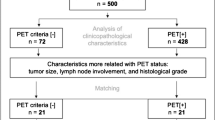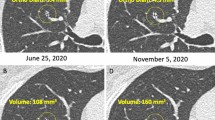Abstract
Background
pStage I includes clinicopathologically diverse groups. This study aimed to identify the prognostic factors for pStage I lung adenocarcinoma.
Methods
We retrospectively reviewed 208 patients with pStage I adenocarcinomas who underwent curative resection in our institute between 2006 and 2013. The maximum standardized uptake value (SUVmax) on [F18]-fluoro-deoxy-d-glucose positron emission tomography-computed tomography (PET/CT) was evaluated. Adenocarcinomas were categorized into the following histologic groups: group 0 (minimally invasive adenocarcinoma and lepidic predominant adenocarcinoma), group 1 (papillary predominant adenocarcinoma), and group 2 (acinar predominant adenocarcinoma and all the remaining subtypes). We assessed the relationship between disease-free survival (DFS) and clinicopathological factors.
Results
Multivariate analysis of DFS demonstrated that SUVmax > 3.0 (p < 0.001), total tumor size > 20 mm (p = 0.016), and histologic groups (p < 0.05) were independent prognostic factors. The prognostic risk score (PRS) was calculated using the following equation: PRS = SUVmax (≤ 3.0: 0 point, > 3.0: 2 points) + total tumor size (≤ 20 mm: 0 point, > 20 mm: 1 point) + histologic group (group 0: 0 point, group 1: 1 point, group 2: 2 points). Patients were divided into the following three risk groups: low-risk (PRS 0–2 points, n = 136), intermediate-risk (PRS 3–4 points, n = 49), and high-risk groups (PRS 5 points, n = 13). The 5-year DFS rates were 93.2%, 50.6%, and 30.8% for the low-, intermediate-, and high-risk groups, respectively (p < 0.001).
Conclusions
The PRS aggregating the FDG-PET/CT SUVmax, total tumor size, and histologic group predicts the prognosis of pStage I lung adenocarcinoma.




Similar content being viewed by others
References
Fu C, Liu Z, Zhu F et al (2016) A meta-analysis: is low-dose computed tomography a superior method for risky lung cancers screening population? Clin Respir J 10:333–341
Sawabata N, Miyaoka E, Asamura H et al (2011) Japanese lung cancer registry study of 11,663 surgical cases in 2004: demographic and prognosis changes over decade. J Thorac Oncol 6:1229–1235
Masuda M, Committee for Scientific Affairs, The Japanese Association for Thoracic Surgery et al (2016) Thoracic and cardiovascular surgery in Japan during 2014: annual report by the Japanese association for thoracic surgery. Gen Thorac Cardiovasc Surg 64:665–697
Goldstraw P, Crowley J, Chansky K et al (2007) The IASLC lung cancer staging project: proposals for the revision of the TNM stage groupings in the forthcoming (seventh) edition of the TNM classification of malignant tumours. J Thorac Oncol 2:706–714
Yoshizawa A, Sumiyoshi S, Sonobe M et al (2013) Validation of the IASLC/ATS/ERS lung adenocarcinoma classification for prognosis and association with EGFR and KRAS gene mutations: analysis of 440 Japanese patients. J Thorac Oncol 8:52–61
Yang HC, Kim HR, Jheon S et al (2015) Recurrence risk-scoring model for stage I adenocarcinoma of the lung. Ann Surg Oncol 22:4089–4097
Uehara H, Tsutani Y, Okumura S et al (2013) Prognostic role of positron emission tomography and high-resolution computed tomography in clinical stage IA lung adenocarcinoma. Ann Thorac Surg 96:1958–1965
Kadota K, Colovos C, Suzuki K et al (2012) FDG-PET SUVmax combined with IASLC/ATS/ERS histologic classification improves the prognostic stratification of patients with stage I lung adenocarcinoma. Ann Surg Oncol 19:3598–3605
Nair VS, Krupitskaya Y, Gould MK (2009) Positron emission tomography 18F-fluorodeoxyglucose uptake and prognosis in patients with surgically treated, stage I non-small cell lung cancer: a systematic review. J Thorac Oncol 4:1473–1479
Sun Y, Hou L, Yang Y et al (2016) Two-gene signature improves the discriminatory power of IASLC/ATS/ERS classification to predict the survival of patients with early-stage lung adenocarcinoma. Oncol Targets Ther 9:4583–4591
Yoshizawa A, Motoi N, Riely GJ et al (2011) Impact of proposed IASLC/ATS/ERS classification of lung adenocarcinoma: prognostic subgroups and implications for further revision of staging based on analysis of 514 stage I cases. Mod Pathol 24:653–664
Takahashi Y, Horio H, Hato T et al (2015) Prognostic significance of preoperative neutrophil-lymphocyte ratios in patients with stage I non-small cell lung cancer after complete resection. Ann Surg Oncol 22(Suppl 3):S1324–1331
Yoshino I, Kawano D, Oba T et al (2006) Smoking status as a prognostic factor in patients with stage I pulmonary adenocarcinoma. Ann Thorac Surg 81:1189–1193
Hamada C, Tanaka F, Ohta M et al (2005) Meta-analysis of postoperative adjuvant chemotherapy with tegafur-uracil in non-small-cell lung cancer. J Clin Oncol 23:4999–5006
Kato H, Ichinose Y, Ohta M et al (2004) A randomized trial of adjuvant chemotherapy with uracil-tegafur for adenocarcinoma of the lung. N Engl J Med 350:1713–1721
Toba H, Kondo K, Sadohara Y et al (2013) 18F-fluorodeoxyglucose positron emission tomography/computed tomography and the relationship between fluorodeoxyglucose uptake and the expression of hypoxia-inducible factor-1alpha, glucose transporter-1 and vascular endothelial growth factor in thymic epithelial tumours. Eur J Cardiothorac Surg 44:e105–112
Travis WD, Brambilla E, Noguchi M et al (2011) International association for the study of lung cancer/American thoracic society/European respiratory society international multidisciplinary classification of lung adenocarcinoma. J Thorac Oncol 6:244–285
Nakamura H, Saji H, Shinmyo T et al (2015) Close association of IASLC/ATS/ERS lung adenocarcinoma subtypes with glucose-uptake in positron emission tomography. Lung Cancer 87:28–33
Russell PA, Wainer Z, Wright GM et al (2011) Does lung adenocarcinoma subtype predict patient survival?: a clinicopathologic study based on the new international association for the study of lung cancer/American thoracic society/European respiratory society international multidisciplinary lung adenocarcinoma classification. J Thorac Oncol 6:1496–1504
Watanabe K, Nomori H, Ohtsuka T et al (2006) [f-18]fluorodeoxyglucose positron emission tomography can predict pathological tumor stage and proliferative activity determined by Ki-67 in clinical stage IA lung adenocarcinomas. Jpn J Clin Oncol 36:403–409
Paesmans M, Berghmans T, Dusart M et al (2010) Primary tumor standardized uptake value measured on fluorodeoxyglucose positron emission tomography is of prognostic value for survival in non-small cell lung cancer: Update of a systematic review and meta-analysis by the European lung cancer working party for the international association for the study of lung cancer staging project. J Thorac Oncol 5:612–619
Gu J, Lu C, Guo J et al (2013) Prognostic significance of the IASLC/ATS/ERS classification in Chinese patients-a single institution retrospective study of 292 lung adenocarcinoma. J Surg Oncol 107:474–480
Warth A, Muley T, Meister M et al (2012) The novel histologic international association for the study of lung cancer/American thoracic society/European respiratory society classification system of lung adenocarcinoma is a stage-independent predictor of survival. J Clin Oncol 30:1438–1446
Tsuta K, Kawago M, Inoue E et al (2013) The utility of the proposed IASLC/ATS/ERS lung adenocarcinoma subtypes for disease prognosis and correlation of driver gene alterations. Lung Cancer 81:371–376
Kadota K, Yeh YC, Sima CS et al (2014) The cribriform pattern identifies a subset of acinar predominant tumors with poor prognosis in patients with stage I lung adenocarcinoma: a conceptual proposal to classify cribriform predominant tumors as a distinct histologic subtype. Mod Pathol 27:690–700
Nakazato Y, Maeshima AM, Ishikawa Y et al (2013) Interobserver agreement in the nuclear grading of primary pulmonary adenocarcinoma. J Thorac Oncol 8:736–743
Takamochi K, Oh S, Matsunaga T et al (2017) Prognostic impacts of EGFR mutation status and subtype in patients with surgically resected lung adenocarcinoma. J Thorac Cardiovasc Surg 154(1768–1774):e1761
Lin CY, Wu YM, Hsieh MH et al (2017) Prognostic implication of EGFR gene mutations and histological classification in patients with resected stage I lung adenocarcinoma. PLoS ONE 12:e0186567
Hung JJ, Yeh YC, Jeng WJ et al (2014) Predictive value of the international association for the study of lung cancer/American thoracic society/European respiratory society classification of lung adenocarcinoma in tumor recurrence and patient survival. J Clin Oncol 32:2357–2364
Yanagawa N, Shiono S, Abiko M, Ogata SY, Sato T, Tamura G (2014) The correlation of the international association for the study of lung cancer (IASLC)/American thoracic society (ATS)/European respiratory society (ERS) classification with prognosis and EGFR mutation in lung adenocarcinoma. Ann Thorac Surg 98:453–458
Xu CH, Wang W, Wei Y et al (2015) Prognostic value of the new international association for the study of lung cancer/American thoracic society/European respiratory society classification in stage IB lung adenocarcinoma. Eur J Surg Oncol 41:1430–1436
Arriagada R, Auperin A, NSCLC Meta-analyses Collaborative Group et al (2010) Adjuvant chemotherapy, with or without postoperative radiotherapy, in operable non-small-cell lung cancer: Two meta-analyses of individual patient data. Lancet 375:1267–1277
Pignon JP, Tribodet H, Scagliotti GV et al (2008) Lung adjuvant cisplatin evaluation: a pooled analysis by the lace collaborative group. J Clin Oncol 26:3552–3559
Douillard JY, Rosell R, De Lena M et al (2006) Adjuvant vinorelbine plus cisplatin versus observation in patients with completely resected stage IB-IIIA non-small-cell lung cancer (Adjuvant Navelbine International Trialist Association [ANITA]): a randomised controlled trial. Lancet Oncol 7:719–727
Winton T, Livingston R, Johnson D et al (2005) Vinorelbine plus cisplatin vs. observation in resected non-small-cell lung cancer. N Engl J Med 352:2589–2597
Arriagada R, Bergman B, Dunant A et al (2004) Cisplatin-based adjuvant chemotherapy in patients with completely resected non-small-cell lung cancer. N Engl J Med 350:351–360
Detterbeck FC, Boffa DJ, Kim AW, Tanoue LT (2017) The eighth edition lung cancer stage classification. Chest 151:193–203
Author information
Authors and Affiliations
Corresponding author
Ethics declarations
Conflict of interest
No author has any conflict of interest.
Additional information
Publisher's Note
Springer Nature remains neutral with regard to jurisdictional claims in published maps and institutional affiliations.
Electronic supplementary material
Below is the link to the electronic supplementary material.
10147_2020_1637_MOESM2_ESM.tif
Online Resource 2. Relationship between the prognostic risk score and OS. The 5-year OS rates were 97.5%, 75.9%, and 44.9% for the low-risk group, intermediate-risk group, and high-risk group, respectively. Significant differences were observed between the low- and intermediate-risk groups and between the low- and high-risk groups (p < 0.05). OS = overall survival
About this article
Cite this article
Kawakita, N., Toba, H., Kawakami, Y. et al. Use of a prognostic risk score that aggregates the FDG-PET/CT SUVmax, tumor size, and histologic group for predicting the prognosis of pStage I lung adenocarcinoma. Int J Clin Oncol 25, 1079–1089 (2020). https://doi.org/10.1007/s10147-020-01637-6
Received:
Accepted:
Published:
Issue Date:
DOI: https://doi.org/10.1007/s10147-020-01637-6




